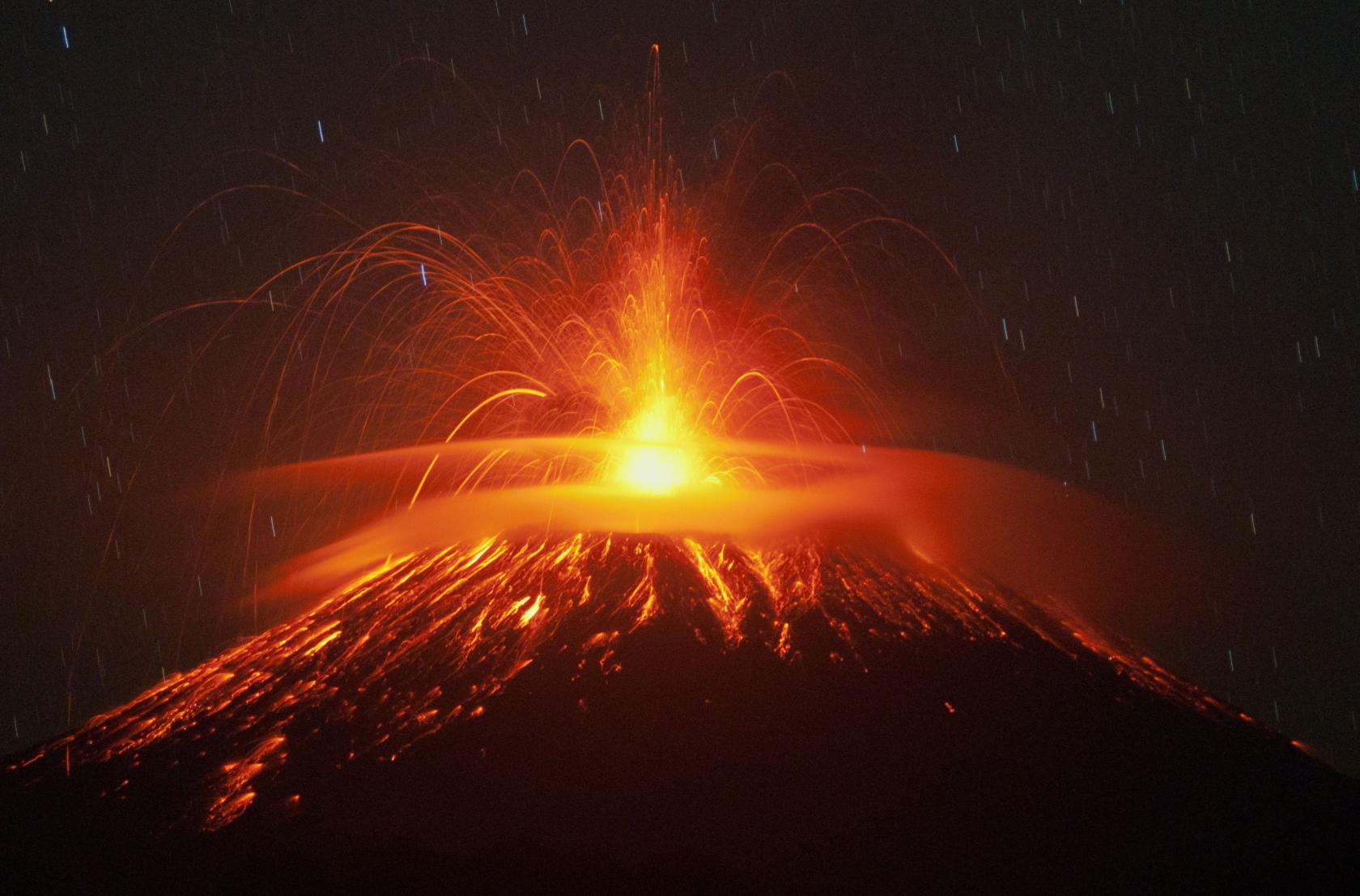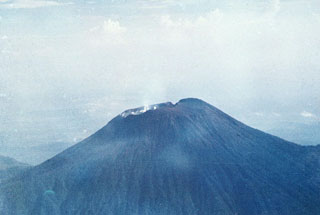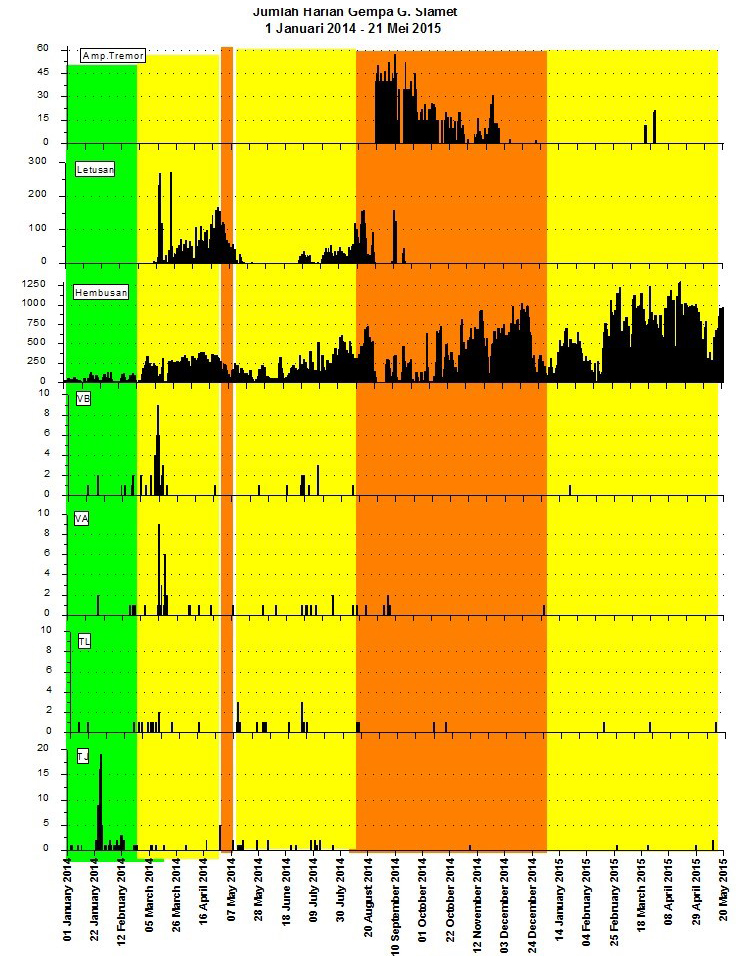Report on Slamet (Indonesia) — July 2015
Bulletin of the Global Volcanism Network, vol. 40, no. 7 (July 2015)
Managing Editor: Edward Venzke.
Edited by A. Elizabeth Crafford. Research and preparation by Robert Andrews.
Slamet (Indonesia) Eruption with ash plumes and incandescent lava, 14 March-18 September 2014
Please cite this report as:
Global Volcanism Program, 2015. Report on Slamet (Indonesia) (Crafford, A.E., and Venzke, E., eds.). Bulletin of the Global Volcanism Network, 40:7. Smithsonian Institution. https://doi.org/10.5479/si.GVP.BGVN201507-263180
Slamet
Indonesia
7.242°S, 109.208°E; summit elev. 3428 m
All times are local (unless otherwise noted)
The most recent Bulletin report on Slamet volcano detailed an eruption from approximately April to June 2009 (BGVN 34:05). From January 2011 to May 2015 (the period covered by this report), one period of eruptive activity occurred between 14 March and 18 September 2014. The eruption was characterized by ash plumes up to 4.6 km, ashfall up to 20 km from the summit, and numerous incandescent lava ejections. Thermal anomalies from this eruption were recorded in the MODIS/MODVOLC satellite data and two reports of ash explosions were observed by the Darwin Volcanic Ash Advisory Center (VAAC). Between late September 2014 and May 2015, the volcano continued emitting steam plumes but there were no further explosions.
The Pusat Vulkanologi dan Mitigasi Bencana Geologi (PVMBG, also known as Indonesian Center for Volcanology and Geological Hazard Mitigation) reported that between 6 September 2009 and July 2011 there were no eruptions from Slamet. Intermittent steam plumes rose as high as 500 m above the crater. Seismicity and the temperature of hot water from nearby springs both decreased from earlier levels. On 11 July 2011, the Alert Level was lowered to 1 (meaning normal, on a scale of 1-4). No further reports of Slamet volcanic activity were offered until March 2014.
Renewed activity during March-September 2014. Both shallow and deep volcanic earthquakes at Slamet increased in frequency beginning in early March 2014. Observers at a post in Slamet Gambuhan village, about 10 km N of the volcano, also noted that increasingly dense steam plumes rose to 600 m during the first week (1-7 March), and up to 1,000 m during 8-10 March. This prompted PVMBG to raise the Alert level from 1 to 2 on 10 March for the first time in 3 years. Steam plumes were rising as high as 1.2 km by 14 March when incandescence from the crater was observed at 2148 during an eruption. Ash plumes rose 800-1,000 m and drifted E.
Brownish-white steam plumes rose as high as 2 km during 15-21 March 2014. For the rest of March and April, white steam plumes rising to 600 or 800 m were more typical. Ash explosions were observed every week from 15 March through late April, rising as high as 2,000 m in late March and early April, drifting both E and W, depending on weather conditions. An increase in intensity of the explosions near the end of April prompted PVMBG to raise the Alert level to 3 for a brief period between 30 April and 12 May, requiring people to stay at least 4 km from the volcano. Ejecta from the volcano fell 300 m from the summit during 19-25 April. Tephra during 26-30 April fell as far as 1,500 m W of the summit with ash plumes rising to 1,700 m. Incandescence was observed hundreds of times between 26 and 29 April. The rumbling reported between 27-29 April was strong enough to rattle windows at the observation post 10 km N. MODIS/MODVOLC thermal satellite data recorded hot spots during 18-30 April, correlating well with the observations of incandescence.
Various seismic signals including explosion earthquakes, emission earthquakes, and shallow and deep volcanic earthquakes fluctuated during 8-28 March 2014. During 29 March-30 April 2014 seismicity from explosions and emissions increased noticeably (figure 4) and inflation was detected. There was also a dramatic increase from 6% to over 70% in the dissolved carbon dioxide content of a hot spring on the south side of Slamet during 17-20 March 2014.
PVMBG reported that in May 2014, incandescence was visible 14 times and there were ash plumes reaching 150-1,500 m above the summit that drifted NW and W. White steam plumes were typically visible 300-800 m above the summit. The volcano was quieter in early June with steam plumes rising only to 500 m and no ash explosions reported. Eruptive activity steadily increased from mid-June through August. During 15-30 June there were 14 moderate explosions reported that generated ash plumes 500-1,400 m above the summit and drifted N and W. Thirty-one explosions of ash were observed during the first two weeks of July that generated 300-1,500 m high plumes, drifting N and W. A very active interval with 148 observed ash plumes from 15 to 31 July sent plumes up to 2,000 m above the summit that drifted N and E. Based on analyses of satellite imagery and wind data, the Darwin VAAC reported that on 18 July 2014 a low-level ash plume rose to an altitude of 4.6 km (15,000 ft) and drifted 83 km W and N.
In early August 2014 thick gray ash plumes rose 300-800 m above the summit drifting N, E, and W, with 100 explosions observed between 1 and 12 August. Seismicity also increased, and ejected material was deposited on the flanks as far as 1,500 m to the W and SW from the crater. Incandescence and rumbling/roaring noises were also reported. The Alert Level was again raised to 3 on 12 August 2014 and remained there through the end of 2014.
A large number of incandescent lava ejections were reported during September. One active period that month was 9-11 September, when brownish steam plumes rose to 1,500 m and incandescent lava ejections were observed up to 600 m above the summit more than 200 times. On 17 September a 1,200-m-high ash plume drifted S and SW from the summit, and several incandescent lava ejections were observed up to 500 m above the summit. Ash deposits 0.1-0.2 mm thick was reported 20 km S of the volcano. Darwin VAAC also reported ash drifting E at 4.6 km (15,000 ft). Incandescent ejections and a 500-m-high ash plume drifting W was also observed on 18 September (figure 5). The MODVOLC satellite image data again reported hot spots at Slamet between 28 July and 12 September 2014, which correlates with the most observations of incandescence from the volcano during this time.
 |
Figure 5. Mount Slamet emits lava and gas during its eruption as seen from Pandansari village in Brebes, Central Java, Indonesia on 18 September 2014. (Photo by Idhad Zakaria (AP) from time.com). |
While seismicity during March and April was dominated by emissions and explosion signals, during mid-September and October high amplitude tremors were abundant before tapering off at the end of November. Explosion signals stopped after mid-September, but the emission signals continued strongly through the period, although no more ash explosions were reported (figure 4). Deformation data indicated that relatively little pressure was accumulating due to magma movement.
Post-eruption, September 2014-May 2015. Activity at Slamet decreased considerably after 18 September. There were no reports recorded for October. Except for a report in early November of steam plumes rising to 1,500 m, the plumes remained at or below 500 m through early January. Deformation and geochemical data showed no significant changes during this period. The Alert Level was lowered to 2 on 5 January 2015.
During 1 February-10 April 2015 dense white plumes rose 50-800 m above Slamet's crater. Seismicity consisted of emission signals and a few tremors. The emission signals started to increase on 18 February and periods of continuous tremors were recorded during 21-22 and 28-29 March 2015, although no explosions were reported. Dense white plumes reported by PVMBG during 21 April-21 May 2015 rose up to 700 m above the crater with continued emission-related seismicity.
Geological Summary. Slamet is one of Java's most active volcanoes. It has a cluster of about three dozen cinder cones on its lower SE-NE flanks and a single cinder cone on the W flank. It is composed of two overlapping edifices, an older basaltic andesite to andesitic volcano on the west and a younger basaltic to basaltic andesite one on the east. Gunung Malang II cinder cone on the upper E flank on the younger edifice fed a lava flow that extends 6 km E. Four craters occur at the summit of Gunung Slamet, with activity migrating to the SW over time. Eruptions recorded since the 18th century have originated from a 150-m-deep, 450-m-wide, steep-walled crater at the western part of the summit and have consisted of explosive eruptions generally lasting a few days to a few weeks.
Information Contacts: Pusat Vulkanologi dan Mitigasi Bencana Geologi (PVMBG, also known as Indonesian Center for Volcanology and Geological Hazard Mitigation, CVGHM), Jalan Diponegoro 57, Bandung 40122, Indonesia (URL: http://www.vsi.esdm.go.id/); Darwin Volcanic Ash Advisory Centre (VAAC), Bureau of Meteorology, Northern Territory regional Office, PO Box 40050, Casuarina, NT 0811, Australia (URL: http://www.bom.gov.au/info/vaac/); Hawai'i Institute of Geophysics and Planetology (HIGP), MODVOLC Thermal Alerts System, School of Ocean and Earth Science and Technology (SOEST), Univ. of Hawai'i, 2525 Correa Road, Honolulu, HI 96822, USA (URL: http://modis.higp.hawaii.edu/); Time.com, 18 September 2014 (URL: http://time.com/3397931/mount-slamet-volcano-indonesia/).


